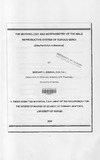| dc.description.abstract | The Morphology of the male reproductive system of rufous sengi was studied
using light and electron microscopy while the testicular morphometry was studied
using stereological techniques. The system consisted of cylindrical-shaped
testes, genital ducts, accessory sex glands and the penis.
The testes were intra-abdominal, located just caudal to the kidneys and
comprised of a parenchyma bound by tunica albuginea. The parenchyma was
composed of the seminiferous tubules and the interstitial tissue; the former being
more predominant than the later and exhibiting complete spermatogenesis. The
interstitial tissue occurred either between the seminiferous tubules, mainly in
relatively larger spaces formed when three or four seminiferous tubules
approximate one another or beneath the tunica albuginea. The Leydig cells were
generally polyhedral with irregular nuclei and had numerous lipid droplets within
their cytoplasm but, in cases where the interstitial tissue made extensions into
narrow spaces between adjoining seminiferous tubules, the Leydig cells therein
were elongate with rod-shaped nuclei.
The testicular arteries branched off from renal arteries and ran cando-laterally to
the testis without convolutions or intimate association with the vein. The testicular
veins also followed a straight course, without pampiniform plexuses. These
animals had separate right and left caudal vena cavae which received ipsilateral
testicular and renal veins. After receiving the renal veins, the left caudal vena
cava crossed to the right side to join the right one to form a common caudal vena
cava which then extended cranially up to the right atrium.
The genital ducts comprised of the rete testis, efferent ductules, epididymis,
ductus deferens and the urethra. The rete testis was made up of
interconnecting channels located outside the testicular parenchyma while the
efferent ductules connected the rete testis to the caput epididymis. The
epididymis consisted of a highly coiled duct organized into three topographic
regions; the caput, corpus and cauda epididymis. The caput epididymis was
applied on dorso-Iateral border, extending from cranial to the caudal pole of the
testis. The corpus epididymis extended caudally from the caput to a position
between the pelvic urethra and the rectum where it joined the cauda epididymis.
The cauda epididymis was organized into a pear-shaped mass, located in a
somewhat lateral position between the rectum and the pelvic urethra. The caput
and corpus epididymis were lined by a tall pseudostratified columnar epithelium
while the cauda epididymis was lined by cuboidal or low columnar epithelium.
The ductus deferens was short, connecting the cauda epididymis to the pelvic
urethra. The urethra consisted of two parts; the pelvic and the penile urethra.
The pelvic urethra, surrounded by a thick muscular coat, extended from the
neck of the urinary bladder to the bulb of the penis and received the ductus
deferens, uterus masculinus and the ducts of the accessory sex glands. The
penile urethra extended from the bulb to the tip of the penis.
The accessory sex glands consisted of the prostate and bulbourethral glands but
without vesicular glands. The prostate gland was made up of several paired
lobes organized into two groups; the cranial and the caudal group of lobes, also
referred to as the cranial and the caudal prostates respectively. The cranial
prostate consisted of lobes organized around the neck of urinary bladder and
included the ventral, latero-dorsal and the medio-dorsallobes. The caudal
prostate consisted of a single pair of lobes located dorsal to the pelvic urethra.
The bulbourethral gland consisted of a pair of medio-Iaterally flattened glands
found laterally at about the junction brtween the pelvic urethra and the bulb of
penis.
The mean reference volume of the sengi testis was 0.089 ± 0.003 ern", 98.3% of
which was constituted by the parenchyma and the rest being contributed by the
capsule. The seminiferous tubules occupied 90.94% of the testicular
parenchyma, while the interstitial tissue, on the other hand, occupied about
9.07%. Out of this total interstitial tissue volume, 7.6% was contributed by the
subcapsular interstitial tissue.
The morphology of the male reproductive system of the sengi and the pattern of
testicular blood vessels was generally similar to that of the African elephant and
the rock hyrax, supporting the existence of close phylogenetic relationships
between these animals as earlier suggested. Additionally, the pattern of testicular
blood vessels suggest that they play no role in testicular thermoregulation. The
separate left and right caudal vena cava is most likely due to retention of
embryonic pattern to adulthood. The morphometric data on the testis confirmed,
with quantification, that the parenchyma of sengi's testis is predominated by the
seminiferous tubules with little interstitial tissue. | en |

